Flying Tumblers And Highfliers Pigeon!
Known for their impressive aerial abilities, Highflyers and Flying Tumblers are two of the most popular pigeon breeds among bird lovers.
They have been domesticated for centuries and kept as pets not only due to this but also because of their unique physical traits. Even now, a big part of the tamed pigeons is of these two breeds.
Let’s know more about their physical characteristics, behavioral differences, cost, care and maintenance, food, lifespan, and many more.
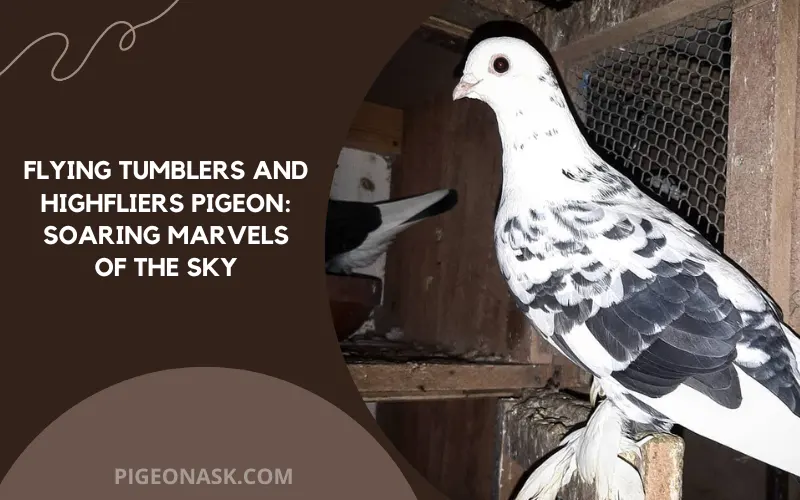
A Short Overview of the Flying Tumblers and Highfliers Pigeons
Flying Tumblers got their name from their ability to tumble when flying. Tumbling is a trait where they tumble to their back or side and fall straight for a long height.
Rather than a specific breed, it points to a category of such birds with this specific capability. It’s believed to be a characteristic that they developed while trying to avoid predator birds while flying in the wild.
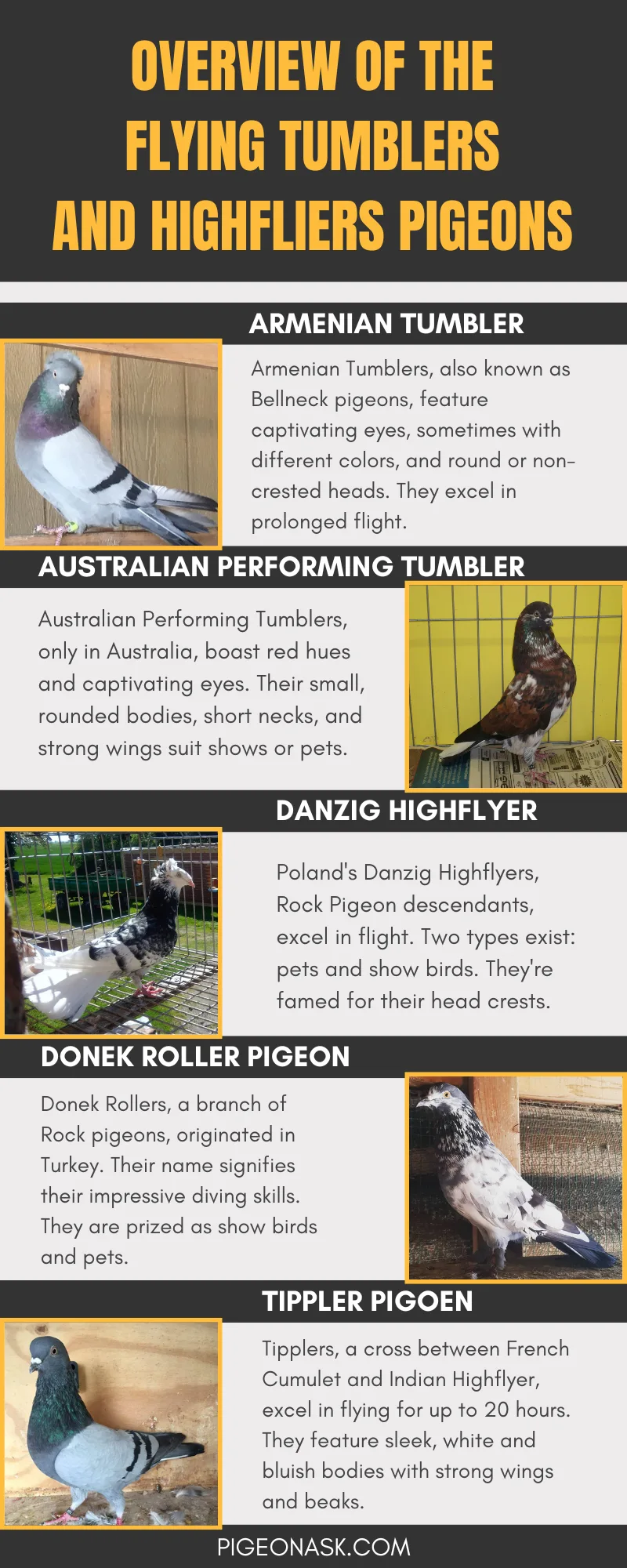
On the other hand, Highfliers are mainly bred for their fascinating ability to fly to great heights for a long time.
They are also very intelligent and have a strong homing sense. This is why Highfliers can fly a long way and still find their way back home.
| Classification | Measurements |
|---|---|
| Scientific Name: Columba livia f. domestica | Length: 20-26 cm |
| Other name: Tumbler & Highflier | Wingspan: 64-72 cm |
| Family: Pigeon | Weight: 255-300 g |
The following 5 breeds are the most common and popular from Flying Tumblers and Highfliers pigeons –
1. Armenian Tumbler
Also known as the Bellneck pigeons, the Armenian Tumbler pigeons were first found in America. These pigeons have beautiful eyes with pearly, orange, or yellow color.
Often, they are also seen to have different colors for each eye, which is a very popular trait of these pigeons.
Besides, Armenian Tumblers have round crested or non-crested heads and a slightly pink beak. They are also excellent flying pigeons and can fly for 2-3 hours continuously.
2. Australian Performing Tumbler
With reddish color and beautiful pearly eyes, Australian Performing Tumblers are quite a beautiful breed. These quiet-natured birds are found only in Australia.
They’re usually small with a short body, a rounded head, and a clean, short neck.
People keep these birds as pets or for shows and exhibitions. They are known for their tumbling traits and have very strong wings for this specific purpose.
3. Danzig Highflyer
Originating in Poland, Danzig Highflyers is a direct descendant of Rock Pigeons. This fancy breed is known for its impressive flying abilities.
There are usually two types of Danzig Highflyers, bred for different purposes: pets and for shows/exhibitions. Appearance-wise, they are most recognized for the beautiful crest on top of their head.
4. Donek Roller
This one is also a family of Rock pigeons. Donek rollers first originated in Turkey. They are also known as the Pristine Roller.
The name Donek means ‘turning and dropping down from the sky,’ which refers to their outstanding diving abilities.
Their ‘spiral diving‘ technique makes them especially popular as show birds. Donek rollers also make for excellent pets.
5. Tippler
A cross between French Cumulet and Indian Highflyer, Tippler is one of the most unique pigeon breeds. With very impressive flying abilities, Tipplers can fly continuously for up to 20 hours! They are also easy to train.
Apart from the flying traits, Tipplers are also unique and beautiful appearance-wise. They may vary in size, but the body shape is sleek with a white and bluish color. Besides, they have strong wings and beaks.
Looking for more articles about pigeon type:
Common Physical Appearance and Unique Features
Since different types of Highfliers and Tumbler pigeons all look different from each other, there are no specific identification signs. However, they are usually strong-built and have well-formed wings with a large wingspan.
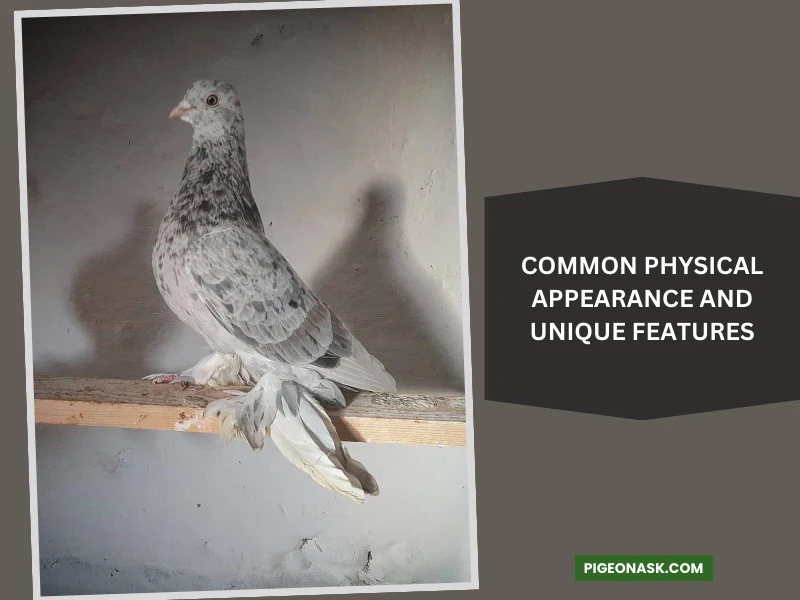
The shape and size are oval and medium-sized. Most of the time, the head is smooth without crests for Tumbler, while Highfliers may have a slight shell crest. Also, there is usually coloration in the plumage.
Overall, Highfliers and Tumblers are both pretty attractive pigeon breeds. They have some of the most unique physical traits among fancy pigeons, such as –
- Coloration of their plumage( black, blue, brown, white, etc)
- Roundhead
- Short or medium-length beak
- Slightly thick neck
- Long and wide wing feathers
- Strong, formed wings
- Different eye colors (pearly, red, yellow, etc)
- Smaller pupil
Behavior and Personality
The behavioral traits of highflyers and flying Tumblers include social, territorial, feeding, etc.
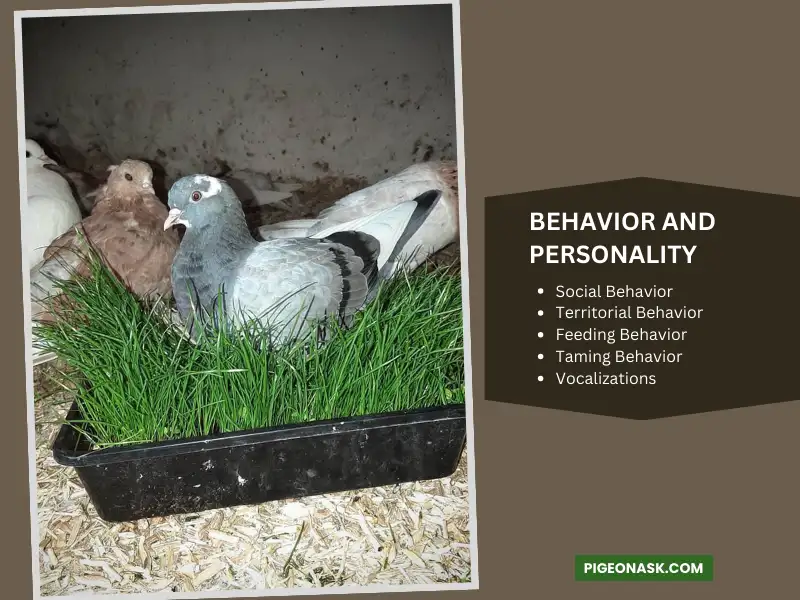
Social Behavior
Like all the other breeds, Tumbler and highflyer pigeons are also social birds. They move and thrive in groups and follow a hierarchical order of relationships to maintain socialization.
This order is not very strict and may change to a flexible egalitarian structure depending on different situations and factors.
Territorial Behavior
Highflier and Tumbler both are extremely territorial breeds and they will fight to protect their region. The marking of territory is done by perch right, where a pigeon will rule the space where it rests or sleeps at night.
In the wild, it includes their nest, nearby tree branches, and the surrounding area.
Feeding Behavior
Highfliers and Tumblers can eat from any common fruits, vegetables, and insects to commercialized food mixes. They will overfeed themselves and become obese, so monitoring while feeding is important.
Besides, they are protective of their food and tend to be competitive when eating. If other pigeons try to steal their food, they will flap their wings and make grunting noises to drive them away.
However, male Highfliers and Tumblers may offer the female food as a courting gesture.
Taming Behavior
Pigeons have been domesticated to keep as pets for a long time now, so they are extremely easy to tame. Once they feel safe enough around you, they will stick around and approach you by themselves.
The main condition of taming wild pigeons like these two breeds is to create a space where they feel protected.
You can also offer them food from afar as a friendly gesture. Using food as a reward is also a very popular taming technique for pigeons.
Once they start to trust you, they will be more interested in spending time with you in close proximity. It’s a slow process, but a sure approach to taming them.
Vocalizations
The common sounds of pigeons are the same for different breeds, including Highfliers and Flying Tumblers. They can make a series of different noises with their throat. Sometimes, they also use their wings to create sounds.
The following are the most common sounds made by Tumblers and Highfliers –
- Cooing sound – For communicating and showing affection
- Whistling and squawking – Made by baby pigeons to gain the attention of the adults
- Grunting – Distressed or angry sounds to show protectiveness and anger
- Flapping sound – Made by wings
- Strutting and tapping sounds – made by feet
- Fanning sound – Made by the tail
Diet of Flying Tumblers and Highfliers Pigeon
Raising flying Tumblers and Highfliers, it’s normal to question whether they require any special diet or not. They are not picky eaters and will eat a variety of different vegetables, fruits, seeds, insects, bugs, etc.
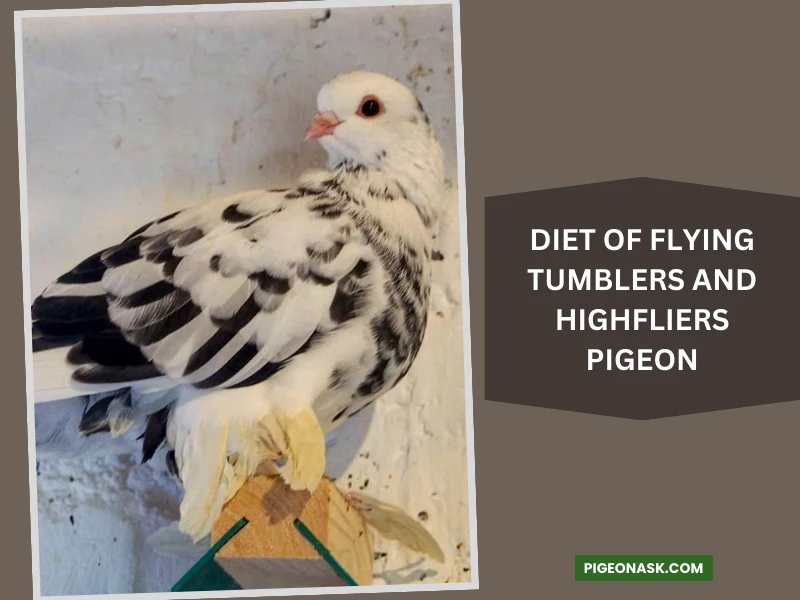
You may also feed them commercial food pellets if you’d like. However, introducing new foods to these pigeons requires special care and monitoring. You should give them a small amount of it to see how they react to it and if it causes any adverse effects on their health.
They will enjoy their food if it’s appropriate for them. In that case, you can gradually increase the amount.
Natural Food
Most Highfliers and Flying Tumblers are adapted to natural food for a larger part of their diet. Take a look at their natural food choices.
Insects and Bugs
Insects are a good source of protein and fat for Highfliers and Tumblers. It keeps them healthy and strong to maintain their flying ability.
Usually, spiders, beetles, worms, small flies, ants, earthworms, and other small insects are the most common insects they can eat without any problem.
Vegetables and Fruits
These energetic pigeons enjoy a variety of fruits and vegetables like cherries, berries, grapes, bananas, kale, spinach, carrots, cucumber, leafy green, herbs, raisins, and vegetables as sources of vitamins.
Some of the vegetables contain carotenoid, which also affects these breeds’ coloration.
Since pigeons don’t have teeth to grind up their food, they just drop the food down their throat. Try to cut up the fruits into smaller pieces when you’re serving them so it’s easier for them to swallow.
Seeds and Grains
Tumblers and Highfliers also like to eat different seeds and grains. It contains minerals, fats, potassium, calcium, etc. Especially in colder seasons, these nutrients from seeds and grains help pigeons maintain body heat.
Grass seed, corn, rice, sunflower seed, millet, sorghum, and flax are some of the seeds and grains that Tumblers and Highflyers enjoy.
Commercial Food
Highflyers and flying Tumblers are naturally much more energetic and active than other pigeon breeds. So, their diet needs to consist of food that can provide the required energy and nutrients.
Commercial food pellets and grain mixes are a great way to make sure they are getting the right amount of energy-rich food to maintain their flight performance.
Usually, you can buy different commercial food mixes available at the market, which are specially for different breeds of pigeons.
They are nutritionally balanced to help maintain the health of show pigeons like Highfliers and Tumblers.
Despite not being picky eaters, some foods should be avoided for these types of pigeon breeds.
These foods are either straight-up harmful or have more negative effects than positive ones on their health.
- Processed meat
- Dairy products
- High sugar, fat, salt-rich food
- Avocado
- Chocolate
- Onions
Lifespan of Flying Tumblers and Highfliers Pigeon
Pigeons have a lifespan of 5-15 years on average. But it can vary depending on their diet, care, habitat, and other factors.
Usually, a highflyer pigeon can live up to almost 15 years if taken care of. Most of the time, they are domesticated, so death from natural predators is less likely.

They are also provided healthcare and proper food, which ensure a longer average lifespan in captivity.
Tumblers also have a similar lifespan, which is around 7-15 years.
On the other hand, in wild habitats, pigeons can fall prey to natural predators, have difficulty finding food, suffer from diseases without proper healthcare, etc.
These adverse situations lessen their average lifespan to around 3-5 years.
Reproduction and Migration
Pigeons are known to mate for life. They reproduce by mating between the male and female, laying eggs, and finally incubating them. However, they need to be at least 7 months old to reach sexual maturity and to start breeding.
In the wild, highflyers and tumblers reproduce naturally, just like any other pigeon breeds. However, in captivity, you’ll have to create the ideal conditions that simulate them to start breeding.
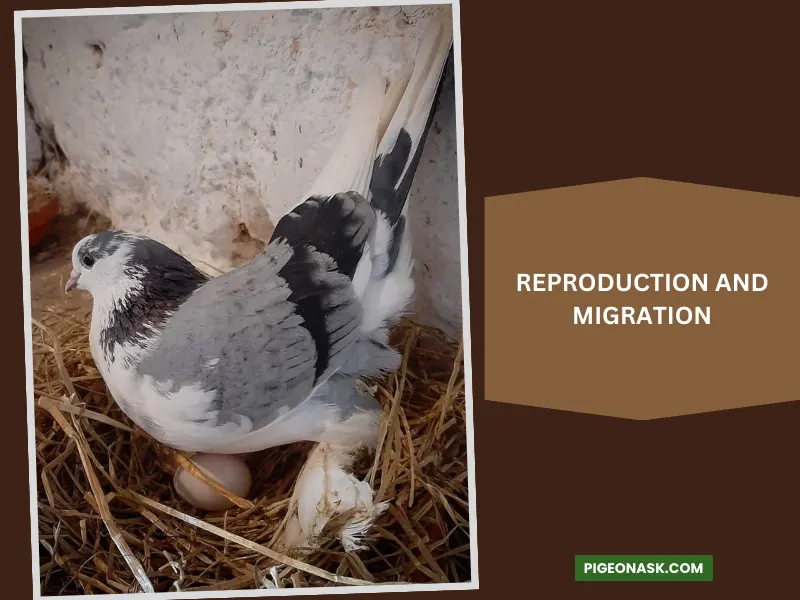
As for migration, pigeons don’t usually migrate. They might however relocate to a nearby place if the current place does not have adequate food and water.
Highflyers and tumblers sometimes get lost while in a racing competition. In such cases, they sometimes get into a group of feral pigeons and continue living with them in the wild.
Geographic Distribution of These Breeds Worldwide
The exact birthplace of flying tumblers and highflyers is hard to pinpoint. They both are descendants of the rock pigeon and are now found all over the world.
The most popular countries for these fancy pigeons are the USA, UK, Iran, Pakistan, India, etc. They are also widely popular in the Middle East.
The Popularity and Cultural Significance of Flying Tumblers and Highfliers Pigeons
The insane popularity of Flying Tumbler and Highfliers is due to their stunning aerial performance. They can fly to great heights and show intricate performances like tumbling or somersaulting.
This is why they have been bred and popularised for shows and exhibitions for a long time.
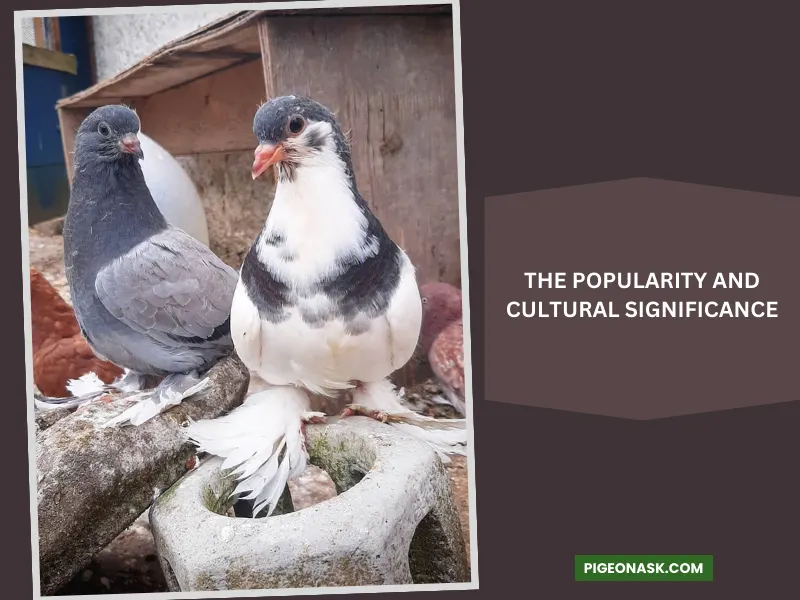
Besides, bird lovers have also shown keen interest in these two breeds due to their coloration and beautiful appearance. These colorations are a result of their selective breeding.
Even today, the popularity of show pigeons is unmatched and Tumblers and Highfliers are definitely at a leading place.
Traditional and Cultural Associations
In many traditions and customs, highflyers are released as an embodiment of freedom. In some cultures, they are also released as a sign of a new beginning, for example, weddings, ceremonies, baptisms, etc.
Pigeon Shows and Competitions
Highflyers and flying tumblers are used mostly for shows and competitions. They are specifically bred and even trained regularly to participate in such racing competitions and exhibitions.
Breeding and Care Tips for Flying Tumblers and Highfliers Pigeons
Flying Tumblers and Highfliers are bred regularly for their high demand. In the wild, they reproduce naturally by courting, mating, laying eggs, and finally incubating them.
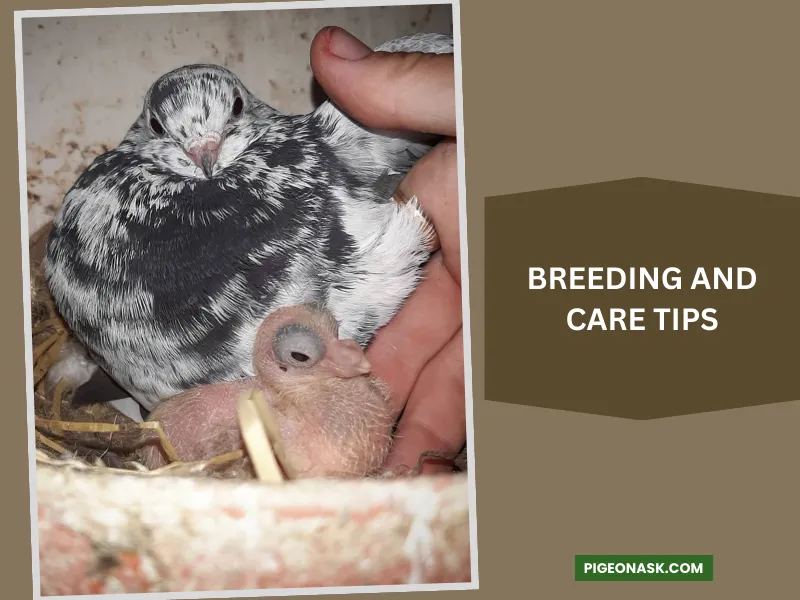
However, if you want to breed them in captivity, the ideal conditions must be provided.
Some of the essential factors for breeding these pigeons are natural light, nutritious food, sufficient water, proper living and nesting space, safety and security, etc.
Let’s learn about the breeding and care tips with an in-depth discussion.
Spacious Living Space
When kept in captivity, highflyers and tumblers need a spacious living space. It should have indoor as well as outdoor space so they can fly around and spend time outside of their house.
Being in a comfortable living space helps keep them healthy and motivated to mate. Also, they like to rest in high places, so creating a high loft or perch is a good idea for such places.
Clean Environment with Proper Ventilation
Make sure there is proper ventilation in and out of the coop to prevent a damp environment. Since bacteria grow faster in such conditions, it’s a must to protect them from common bacterial diseases.
Healthy Diet
Healthy pigeons produce healthy offspring. Especially during their mating season, they require a balanced diet with high calcium for healthy egg formation.
Clean Water for Drinking
A fresh and clean water source is just as important as a healthy diet. They should be able to drink water whenever they need it. Pigeons don’t usually soil the water quickly. However, make sure to replace it with fresh water every other day.
Natural Light
Pigeons rely on their internal clock to keep track of their mating season. This is why natural light and a proper day-night cycle are crucial to facilitate and initiate their mating behavior.
If there is not enough natural sunlight, you can arrange some artificial lighting to trick their biological clock.
Safety
Pigeons need to feel safe and guarded to initiate mating behavior. This is why proper housing with protection from cold, rain, adverse weather, and predators is one of the very first conditions for their breeding.
Comfortable Nesting Boxes
Nesting boxes for pigeons can be easily created by laying some dry straws, bedding materials, soft clothes, etc. Sometimes, they create their own nesting place with dry leaves and whatever else they can find.
Overall, it should be comfortable enough to lay eggs and incubate them eventually.
Enough Social Interaction to Bond Naturally
And finally, pigeons chose their partner by interacting and courting. They show intricate movements and offer food as a courting gesture. Also, they mate for life, so there should be enough male and female pigeons for them to pair up.
Conclusion
Flying Tumblers and Highfliers are two of the most interesting pigeon breeds. With their unique characteristics and beautiful appearances, they can attract every pigeon lover.
Despite being bred mainly for shows and exhibitions, these breeds are equally popular as pets. But they will require special care and thus, you need to have some basic understanding of their traits and maintenance.
Fortunately, we have compiled all of these things here so you can go right ahead.
